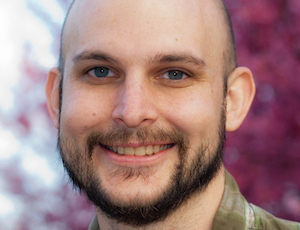Events & Talks
Perceiving Systems
Talk
Karl Abson
14-06-2013
Biomechanical models for animation and life sciences
<p style="text-align: justify;">
<span style="font-family: arial, sans-serif; font-size: 12.727272033691406px;">Motion capture and data driven technologies have come very far over the past few years. In terms of human capture the high volume of research that has gone into this sub group has led to very impressive results. Human motion can now be captured in real time which when used in the creative sectors can lead to blockbuster films such as Avatar. Similarly in the medical sectors these techniques can be used to diagnose, analyse performance and avoid invasive procedures in tasks such...
Perceiving Systems
Talk
Uwe Schmidt
03-06-2013
Discriminative Non-blind Deblurring
<p>
Non-blind deblurring is an integral component of blind approaches for removing image blur due to camera shake. Even though learning-based deblurring methods exist, they have been limited to the generative case and are computationally expensive. To this date, manually-defined models are thus most widely used, though limiting the attained restoration quality. We address this gap by proposing a discriminative approach for non-blind deblurring. One key challenge is that the blur kernel in use at test time is not known in advance. To address this, we analyze existing approaches that use h...
Perceiving Systems
Talk
Olga Sorkine-Hornung
27-05-2013
Interactive Variational Shape Modeling
<p>
Irregular triangle meshes are a powerful digital shape representation: they are flexible and can represent virtually any complex shape; they are efficiently rendered by graphics hardware; they are the standard output of 3D acquisition and routinely used as input to simulation software. Yet irregular meshes are difficult to model and edit because they lack a higher-level control mechanism. In this talk, I will survey a series of research results on surface modeling with meshes and show how high-quality shapes can be manipulated in a fast and intuitive manner. I will outline the current...
Perceiving Systems
Talk
Andrew Fitzgibbon
17-05-2013
3D vision in a changing world
<p>
3D reconstruction from images has been a tremendous success-story of computer vision, with city-scale reconstruction now a reality. However, these successes apply almost exclusively in a static world, where the only motion is that of the camera. Even with the advent of realtime depth cameras, full 3D modelling of dynamic scenes lags behind the rigid-scene case, and for many objects of interest (e.g. animals moving in natural environments), depth sensing remains challenging. In this talk, I will discuss a range of recent work in the modelling of nonrigid real-wo...
Perceiving Systems
Talk
Gerard Pons-Moll
30-04-2013
Human Pose Estimation from Video and Inertial Sensors
Significant progress has been made over the last years in estimating people's shape and motion from video and nonetheless the problem still remains unsolved. This is especially true in uncontrolled environments such as people in the streets or the office where background clutter and occlusions make the problem even more challenging.<br />
The goal of our research is to develop computational methods that enable human pose estimation from video and inertial sensors in indoor and outdoor environments. Specifically, I will focus on one of our past projects in which we introduce a hybrid H...
Perceiving Systems
Talk
Alexei Efros
29-04-2013
What Make Big Visual Data Hard?
<p>
There are an estimated 3.5 trillion photographs in the world, of which 10% have been taken in the past 12 months. Facebook alone reports 6 billion photo uploads per month. Every minute, 72 hours of video are uploaded to YouTube. Cisco estimates that in the next few years, visual data (photos and video) will account for over 85% of total internet traffic. Yet, we currently lack effective computational methods for making sense of all this mass of visual data. Unlike easily indexed content, such as text, visual content is not routinely searched or mined; it's not even hyperlinked. Vis...
Perceiving Systems
Talk
Cristobal Curio
04-03-2013
Novel design principles for interfacing biological and artificial vision for assistive perceiving systems
<p>
Studying the interface between artificial and biological vision has been an area of research that has been greatly promoted for a long time. It seems promising that cognitive science can provide new ideas to interface computer vision and human perception, yet no established design principles do exist. In the first part of my talk I am going to introduce the novel concept of 'object detectability'. Object detectability refers to a measure of how likely a human observer is visually aware of the location and presence of specific object types in a complex, dynamic, urban scene.</p>...
Perceiving Systems
Talk
Oisin Mac Aodha
28-02-2013
Learning a Confidence Measure for Optical Flow
<p>
We present a supervised learning based method to estimate a per-pixel confidence for optical flow vectors. Regions of low texture and pixels close to occlusion boundaries are known to be difficult for optical flow algorithms. Using a spatiotemporal feature vector, we estimate if a flow algorithm is likely to fail in a given region.</p>
<p>
Our method is not restricted to any specific class of flow algorithm, and does not make any scene specific assumptions. By automatically learning this confidence we can combine the output of several computed flow fields from different algorithms to...
Perceiving Systems
Talk
Andreas Müller
27-02-2013
Partial Supervision and latent variable models for semantic image segmentation
<p>
Semantic image segmentation is the task of assigning semantic labels to the pixels of a natural image. It is an important step towards general scene understanding and has lately received much attention in the computer vision community. It was found that detailed annotation of images are helpful for solving this task, but obtaining accurate and consistent annotations still proves to be difficult on a large scale. One possible way forward is to work with partial supervision and latent variable models to infer semantic annotations from the data during training.</p>
<p>
The talk will pre...
Perceiving Systems
Talk
Carsten Rother
25-02-2013
From Particle Stereo to Scene Stereo
<p>
In this talk I will present two lines of research which are both applied to the problem of stereo matching. The first line of research tries to make progress on the very traditional problem of stereo matching. In BMVC 11 we presented the PatchmatchStereo work which achieves surprisingly good results with a simple energy function consisting of unary terms only. As optimization engine we used the PatchMatch method, which was designed for image editing purposes. In BMVC 12 we extended this work by adding to the energy function the standard pairwise smoothness terms. The main contribution...
Perceiving Systems
Talk
Cordelia Schmid
22-01-2013
Large-scale and weakly supervised learning of objects and actions
<p>
We, first, address the problems of large scale image classification. We present and evaluate different ways of aggregating local image descriptors into a vector and show that the Fisher kernel achieves better performance than the reference bag-of-visual words approach for any given vector dimension. We show and interpret the importance of an appropriate vector normalization.</p>
<p>
Furthermore, we discuss how to learn given a large number of classes and images with stochastic gradient descent and show results on ImageNet10k. We, then, present a weakly supervised approach for learnin...
Perceiving Systems
Talk
Oren Freifeld
22-01-2013
Lie Shapes and Statistics on Manifolds
<p>
Three-dimensional object shape is commonly represented in terms of deformations of a triangular mesh from an exemplar shape. In particular, statistical generative models of human shape deformation are widely used in computer vision, graphics, ergonomics, and anthropometry. Existing statistical models, however, are based on a Euclidean representation of shape deformations. In contrast, we argue that shape has a manifold structure: For example, averaging the shape deformations for two people does not necessarily yield a meaningful shape deformation, nor does the Euclidean difference of t...
Perceiving Systems
Talk
Pradeep Krishna Yarlagadda
28-11-2012
Whole is more than the Sum of its Parts: Applications to Object Detection and Beyond
<p>
The grand goal of Computer Vision is to generate an automatic description of an image based on its visual content. Category level object detection is an important building block towards such capability. The first part of this talk deals with three established object detection techniques in Computer Vision, their shortcomings and how they are improved. i) Hough Voting methods efficiently handle the high complexity of multi-scale, category-level object detection in cluttered scenes.</p>
<p>
However, the primary weakness of this approach is that mutually dependent local observations...
Perceiving Systems
Talk
Andreas Geiger
05-11-2012
3D Scene Understanding for Autonomous Vehicles
<p>
Navigating a car safely through complex environments is considered a relatively easy task for humans. Computer algorithms, however, can't nearly match human performance and often rely on 3D laser scanners or detailed maps. The reason for this is that the level and accuracy of current computer vision and scene understanding algorithms is still far from that of a human being. In this talk I will argue that pushing these limits requires solving a set of core computer vision problems, ranging from low-level tasks (stereo, optical flow) to high-level problems (object detection, 3D scen...
Perceiving Systems
Talk
Stefan Roth
24-09-2012
How well do filter-based MRFs model natural images?
<p>
Markov random fields (MRFs) have found widespread use as models of natural image and scene statistics. Despite progress in modeling image properties beyond gradient statistics with high-order cliques, and learning image models from example data, existing MRFs only exhibit a limited ability of actually capturing natural image statistics.</p>
<p>
In this talk I will present recent work that investigates this limitation of previous filter-based MRF models, including Fields of Experts (FoEs). We found that these limitations are due to inadequacies in the leaning procedure and suggest v...
Perceiving Systems
Talk
Hedvig Kjellström
17-09-2012
What You See is Less Than What You Get - Estimating Visually Non-Observable Object Properties
<p>
The great majority of object analysis methods are based on visual object properties - objects are categorized according to how they appear in images. Visual appearance is measured in terms of image features (e.g., SIFTs) extracted from images or video. However, besides appearance, objects also have many properties that can be of interest, e.g., for a robot who wants to employ them in activities: Temperature, weight, surface softness, and also the functionalities or affordances of the object, i.e., how it is intended to be used. One example, recently addressed in the vision community, a...
Perceiving Systems
Talk
Anuj Srivastava
17-07-2012
A Framework for Joint Registration and Statistical Shape Analysis of 2D and 3D Objects
<p>
Shape analysis and modeling of 2D and 3D objects has important applications in many branches of science and engineering. The general goals in shape analysis include: derivation of efficient shape metrics, computation of shape templates, representation of dominant shape variability in a shape class, and development of probability models that characterize shape variation within and across classes. While past work on shape analysis is dominated by point representations -- finite sets of ordered or triangulated points on objects' boundaries -- the emphasis has lately shifted to contin...
Perceiving Systems
Talk
Edward H. Adelson
13-07-2012
An approach to light microscopy yielding SEM-like images and 3D surface topography using an elastomeric gelVenue: Werner Köster-Hörsaal (2R4), MPI-IS Stuttgart, Heisenbergstr. 3 Date: Friday, July 13, 2012, 10:30 h
Abstract: We can modify the optical properties of surfaces by “coating” them with a micron-thin membrane supported by an elastomeric gel. Using an opaque, matte membrane, we can make reflected light micrographs with a distinctive SEM-like appearance. These have modest magnification (e.g., 50X), but they reveal fine surface details not normally seen with an optical microscope.
<p>
The system, which we call “GelSight,” removes optical complexities such as specular reflection, albedo, and subsurface scattering, and isolates the shading information that signals 3D sh...
Perceiving Systems
Talk
Edward H. Adelson
12-07-2012
Lines, shading, and the perception of 3D shape
<p>
Human can easily see 3D shape from single 2D images, exploiting multiple kinds of information. This has given rise to multiple subfields (in both human vision and computer vision) devoted to the study of shape-from-shading, shape-from-texture, shape-from-contours, and so on.</p>
<p>
The proposed algorithms for each type of shape-from-x remain specialized and fragile (in contrast with the flexibility and robustness of human vision). Recent work in graphics and psychophysics has demonstrated the importance of local orientation structure in conveying 3D shape. This information is fairl...
Perceiving Systems
Talk
E.J. Chichilnisky
12-07-2012
Probing nonlinear computations in the retina at single cell resolutionBernstein lecture, 12 July, 18:15, Children's Hospital.
<p>
A central aspect of visual processing in the retina is the existence of nonlinear subunits within the receptive fields of retinal ganglion cells. These subunits have been implicated in visual computations such as segregation of object motion from background motion. However, relatively little is known about the spatial structure of subunits and its emergence from nonlinear interactions in the interneuron circuitry of the retina.</p>
<p>
We used physiological measurements of functional circuitry in the isolated primate retina at single-cell resolution, combined with novel computati...
Perceiving Systems
Talk
Ruth Rosenholtz
11-07-2012
What is the representation in early vision?
<p>
Considerable research has demonstrated that the representation is not equally faithful throughout the visual field; representation appears to be coarser in peripheral vision, perhaps as a strategy for dealing with an information bottleneck in visual processing. In the last few years, a convergence of evidence has suggested that in peripheral and unattended regions, the information available consists of summary statistics.</p>
<p>
For a complex set of statistics, such a representation can provide a rich and detailed percept of many aspects of a visual scene. However, such a representa...
Perceiving Systems
Talk
Martin Giese
26-06-2012
Biologically-inspired learning-based models for the recognition and synthesis of interactive body movements
<p>
Human body movements are highly complex spatio-temporal patterns and their control and recognition represent challenging problems for technical as well as neural systems. The talk will present an overview of recent work of our group, exploiting biologically-inspired learning-based reprensentations for the recognition and synthesis of body motion.</p>
<p>
The first part of the talk will present a neural theory for the visual processing of goal-directed actions, which reproduces and partially correctly predicts electrophysiological results from action-selective cortical neurons in m...
Perceiving Systems
Talk
Ronen Basri
09-05-2012
Object Recognition and Shape Reconstruction under Complex Lighting
<p>
Variations in lighting can have a significant effect on the appearance of an object. Modeling these variations is important for object recognition and shape reconstruction, particularly of smooth, textureless objects. The recent decade has seen significant progress in handling lambertian objects. In that context I will present our work on using harmonic representations to represent the reflectance of lambertian objects under complex lighting configurations and their application to photometric stereo and prior-assisted shape from shading. In addition, I will present preliminary results...
Perceiving Systems
Talk
Carlos Vargas-Irwin
02-05-2012
Exploring the role of ventral premotor cortex in reach-to-grasp movements: neural trajectories through spike train similarity space
<p>
Dimensionality reduction applied to neural ensemble data has led to the concept of a 'neural trajectory', a low-dimensional representation of how the state of the network evolves over time. Here we present a novel neural trajectory extraction algorithm which combines spike train distance metrics (Victor and Purpura, 1996) with dimensionality reduction based on local neighborhood statistics (van der Maaten and Hinton, 2008.) . We apply this technique to describe and quantify the activity of primate ventral premotor cortex neuronal ensembles in the context of a cued reaching and...
Perceiving Systems
Talk
Martin Butz
18-04-2012
A Modular, Multimodal Arm Model: Multisensory Integration and Flexible Motion Control
<p>
Humans interact with their environment in a highly flexible manner. One important component for the successful control of such flexible interactions is an internal body model. To maintain a consistent internal body model, the brain appears to continuously and probabilistically integrate multiple sources of information, including various sensory modalities but also anticipatory, re-afferent information about current body motion. A modular, multimodal arm model (MMM) is presented.</p>
<p>
The model represents a seven degree of freedom arm in various interactive modality frames. The ...
Perceiving Systems
Talk
Cordelia Schmid
16-04-2012
Actions Recognition from Videos: Some Recent Results Cordelia Schmid INRIA
<p>
The amount of digital video content available is growing daily, on sites such as YouTube. Recent statistics on the YouTube website show that around 48 hours of video are uploaded every minute. This massive data production calls for automatic analysis.</p>
<p>
In this talk we present some recent results for action recognition in videos. Bag-of-features have shown very good performance for action recognition in videos. We briefly review the underlying principles and introduce trajectory-based video features, which have shown to outperform the state of the art. These trajectory feature...
Perceiving Systems
Talk
Eric Sommerlade
15-03-2012
Information-driven Surveillance
<p>
The supervision of public spaces aims at multiple objectives, such as early acquisition of targets, their identification and pursuit throughout the supervised area. To achieve these, typical sensors such as pan-tilt-zoom cameras need to either focus on individuals, or provide a broad field of view, which are conflicting control settings. We address this problem in an information-theoretic manner: by phrasing each of the objectives in terms of mutual information, they become comparable. The problem turns into maximisation of information, which is predicted for the next time step and ph...
Perceiving Systems
Talk
Christoph Garbe
13-02-2012
Algorithms for low-cost depth imaging
<p>
Recovering the depth of a scene is important for bridging the gap between the real and the virtual world, but also for tasks such as segmenting objects in cluttered scenes. Very cheap single view depth imaging cameras, i.e. Time of Fight cameras (ToF) or Microsoft's Kinect system, are entering the mass consumer market. In general, the acquired images have a low spatial resolution and suffer from noise as well as technology specific artifacts. In this talk I will present algorithmic solutions to the entire depth imaging pipeline, ranging from preprocessing to depth image analysis. ...
Perceiving Systems
Talk
Ryusuke Sagawa
09-02-2012
One-shot Dense 3D Reconstruction for Objects in Fast Motion
<p>
3D scanning of moving objects has many applications, for example, marker-less motion capture, analysis on fluid dynamics, object explosion and so on. One of the approach to acquire accurate shape is a projector-camera system, especially the methods that reconstructs a shape by using a single image with static pattern is suitable for capturing fast moving object. In this research, we propose a method that uses a grid pattern consisting of sets of parallel lines. The pattern is spatially encoded by a periodic color pattern. While informations are sparse in the camera image, the proposed ...
Perceiving Systems
Talk
Brian Amberg
24-01-2012
Optimal Landmark Detection using Shape Models and Branch and Bound
<p>
Fitting statistical 2D and 3D shape models to images is necessary for a variety of tasks, such as video editing and face recognition. Much progress has been made on local fitting from an initial guess, but determining a close enough initial guess is still an open problem. One approach is to detect distinct landmarks in the image and initialize the model fit from these correspondences. This is difficult, because detection of landmarks based only on their local appearance is inherently ambiguous, making it necessary to use global shape information for the detections. We propose a method ...
Perceiving Systems
Talk
Prof. Dr. David Fleet
23-01-2012
Physics-Based Models for Human Motion Analysis
<p>
This talk concerns the use of physics-based models for human pose tracking and scene inference. We outline our motivation for physics-based models, some results with monocular pose tracking in terms of biomechanically inspired controllers, and recent results on the inference of scene interactions. We show that physics-based models facilitate the estimation of physically plausible human motion with little or no mocap data required. Scene interactions play an integral role in modeling sources of external forces acting on the body.</p>
Perceiving Systems
Talk
Larry Davis
02-12-2011
Context in image (and video) understanding
<p>
In spite of the significant effort that has been devoted to the core problems of object and action recognition in images and videos, the recognition performance of state of the art algorithms is well below what would be required for any successful deployment in many applications. Additionally, there are challenging combinatorial problems associated with constructing globally “optimal” descriptions of images and videos in terms of potentially very large collections of object and action models. The constraints that are utilized in these optimization procedures are loosely r...
Michel Besserve
Perceiving Systems
Talk
Ben Sapp
16-11-2011
Efficient Human Pose Estimation with Higher-order Image Information
<p>
Human pose estimation from monocular images is one of the most challenging and computationally demanding problems in computer vision. Standard models such as Pictorial Structures consider interactions between kinematically-connected joints or limbs, leading to inference quadratic in the number of pixels.</p>
<p>
As a result, researchers and practitioners have restricted themselves to simple models which only measure the quality of limb-pair possibilities by their 2D geometric plausibility. In this talk, we propose novel methods which allow for efficient inference in richer models...
Michel Besserve
Perceiving Systems
Talk
Leonid Sigal
03-11-2011
3D Human Motion Estimation Inside and Out
<p>
Pose estimation and tracking has been a focus of computer vision research for many years. Despite many successes, however, most approaches to date are still not able to recover physically realistic (natural looking) 3d motions and are restricted to captures indoors or with simplified backgrounds. In the first part of this talk, I will briefly introduce a class of models that use physics to constrain the motion of the subject to more realistic interpretations.</p>
<p>
In particular, we formulate the pose tracking problem as one of inference of control mechanisms which implicitly (t...
Michel Besserve
Perceiving Systems
Talk
Stefanie Wuhrer
26-09-2011
Isometry-Invariant Shape Analysis
<p>
Shape analysis aims to describe either a single shape or a population of shapes in an efficient and informative way. This is a key problem in various applications such as mesh deformation and animation, object recognition, and mesh parameterization.</p>
<p>
I will present a number of approaches to process shapes that are nearly isometric. The first approach computes the correspondence information between a population of shapes in this setting. Second and third are approaches to morph between two shapes and to segment a population of shapes into near-rigid components. Next, I will ...
Perceiving Systems
Talk
Søren Hauberg
21-09-2011
A Geometric Approach to Human Motion Modelling
<p>
We propose a geometric approach to articulated tracking, where the human pose representation is expressed on the Riemannian manifold of joint positions. This is in contrast to conventional methods where the problem is phrased in terms of intrinsic parameters of the human pose. Our model is based on a physically natural metric that also has strong links to neurological models of human motion planning. Some benefits of the model is that it allows for easy modeling of interaction with the environment, for data-driven optimization schemes and for well-posed low-pass filtering properties....
Michel Besserve
Perceiving Systems
Talk
Hao Li
19-09-2011
Non-Rigid Registration in Entertainment and Science
<p>
A pure refinement procedure for non-rigid registration can be highly effective for establishing dense correspondences between pairs of scanned data, even for significant deformations. I will explain how to design robust non-rigid algorithms and why it is important to couple the optimization of correspondence positions, warping field, and overlapping regions. I will show several applications where it has been successfully applied ranging from film/game production to radiation oncology. One particular interest of mine is facial animation. I will present a fully integrated system for re...
Gerard Pons-Moll
Perceiving Systems
Talk
Nils Hasler
08-09-2011
There and Back Again or Academia vs. the Visual Effects Industry
<p>
Many machine vision/image processing algorithms are designed to be real-time and fully automatic. These attributes are essential, e.g., for stereo robotics vision applications. Visual Effects Studios, however, posses giant server farms and command armies of artists to perform intelligent initialization or provide guidance to algorithms. On the other hand, motion pictures have very high accuracy requirements and the ability to influence an algorithm manually is often more important than other factors, generally considered crucial in Academia. In this talk I will highlight some scenari...
Michel Besserve
Gerard Pons-Moll
Perceiving Systems
Talk
Avinash Sharma
06-09-2011
3D Shape Segmentation and Matching using Graph Spectral Methods
<p>
In the era of perpetually increasing computational capabilities, multi-camera acquisition systems are being increasingly used to capture parameterization-free articulated 3D shapes. These systems allow marker-less shape acquisition and are useful for a wide range of applications in the entertainment, sports, surveillance industries and also in interactive, and augmented reality systems. The availability of vast amount of 3D shape data has increased interest in 3D shape analysis methods. Segmentation and Matching are two important shape analysis tasks. 3D shape segmentation is a subjec...
Sebastian Trimpe
Perceiving Systems
Talk
Jürgen Gall
18-08-2011
Capturing and Modeling Human Interactions
<p>
Capturing human motion or objects by vision technology has been intensively studied. Although humans interact very often with other persons or objects, most of the previous work has focused on capturing a single object or the motion of a single person. In this talk, I will highlight four projects that deal with human-human or human-object interactions. The first project addresses the problem of capturing skeleton and non-articulated cloth motion of two interacting characters. The second project aims to model spatial hand-object relations during object manipulation. In the third projec...
Philipp Hennig
Michel Besserve
Perceiving Systems
Talk
Peter Gehler
01-08-2011
Recovering Intrinsic Images / Efficient Object Detection
<p>
n this talk I will present recent work on two different topics from low- and high-level computer vision: Intrinsic Image Recovery and Efficient object detection. By intrinsic image decomposition we refer to the challenging task of decoupling material properties from lighting properties given a single image. We propose a probabilistic model that incorporates previous attempts exploiting edge information and combine it with a novel prior on material reflectances in the image. This results in a random field model with global, latent variables and pixel-accurate output reflectance values...
Perceiving Systems
Talk
Yusuf Sahillioglu
18-07-2011
3D Isometric Shape Correspondence
<p>
3D shape correspondence methods seek on two given shapes for pairs of surface points that are semantically equivalent. We present three automatic algorithms that address three different aspects of this problem: 1) coarse, 2) dense, and 3) partial correspondence. In 1), after sampling evenly-spaced base vertices on shapes, we formulate the problem of shape correspondence as combinatorial optimization over the domain of all possible mappings of bases, which then reduces within a probabilistic framework to a log-likelihood maximization problem that we solve via EM (Expectation Maximizati...
Perceiving Systems
Talk
Serge Belongie
04-07-2011
Visual Recognition with Humans in the Loop
<p>
We present an interactive, hybrid human-computer method for object classification. The method applies to classes of problems that are difficult for most people, but are recognizable by people with the appropriate expertise (e.g., animal species or airplane model recognition). The classification method can be seen as a visual version of the 20 questions game, where questions based on simple visual attributes are posed interactively.</p>
<p>
The goal is to identify the true class while minimizing the number of questions asked, using the visual content of the image. Incorporating us...
Perceiving Systems
Talk
Fernando De La Torre
14-06-2011
Learning Components for Human Sensing
<p>
Enabling computers to understand human behavior has the potential to revolutionize many areas that benefit society such as clinical diagnosis, human computer interaction, and social robotics. A critical element in the design of any behavioral sensing system is to find a good representation of the data for encoding, segmenting, classifying and predicting subtle human behavior.</p>
<p>
In this talk I will propose several extensions of Component Analysis (CA) techniques (e.g., kernel principal component analysis, support vector machines, spectral clustering) that are able to learn spatio...
Perceiving Systems
Talk
Javier Romero
14-06-2011
Sensing, modeling and executing object manipulation
<p>
Object grasping and manipulation is a crucial part of daily human activities. The study of these actions represents a central component in the development of systems that attempt to understand human activities and robots that are able to act in human environments.</p>
<p>
Three essential parts of this problem are tackled in this talk: the perception of the human hand in interaction with objects, the modeling of human grasping actions and the refinement of the execution of a robotic grasp. The estimation of the human hand pose is carrried out with a markerless visual system that pe...
Perceiving Systems
Talk
Arto Nurmikko
24-05-2011
Colloidal Semiconductor Nanocrystals as Light Emitters in the Red, Green, and Blue: Device Prospects from Single Photon Emitters to Laser Devices
<p>
Semiconductor light emitters, based on single crystal epitaxial inorganic semiconductor heterostructures are ubiquitous. In spite of their extraordinary versatility and technological maturity, penetrating the full visible spectrum using a single material system for red, green, and blue (RGB) in a seamless way remains, nonetheless, an elusive challenge.</p>
<p>
Semiconductor nanocrystals, or quantum dots (QDs), synthesized by solution-based methods of colloidal chemistry represent a strongly contrasting basis for active optical materials. While possessing an ability to absorb and ef...
Perceiving Systems
Talk
Arto Nurmikko
23-05-2011
Emerging Neurotechnologies for Interfacing the Brain
<p>
Invasive access by microprobe arrays inserted safely into the brain is now enabling us to “listen” to local neural circuits at levels of spatial and temporal detail which, in addition to enriching fundamental brain science, has led to the possibility of a new generation of neurotechnologies to overcome disabilities due to a range of neurological injuries where pathways from the brain to the rest of the central and peripheral nervous systems have been injured or severed. In this presentation we discuss the biomedical engineering challenges and opportunities with these inci...
Perceiving Systems
Talk
Henning Hamer
13-05-2011
Capturing and Synthesizing Hand-Object Interaction
<p>
The scope of this work is hand-object interaction. As a starting point, we observe hands manipulating objects and derive information based on computer vision methods. After considering hands and objects in isolation, we focus on the inherent interdependencies. One application of the gained knowledge is the synthesis of interactive hand motion for animated sequences.</p>
Perceiving Systems
Talk
Vittorio Ferrari
22-04-2011
Toward Autonomous Visual Learning
<p>
Vision is a crucial sense for computational systems to interact with their environments as biological systems do. A major task is interpreting images of complex scenes, by recognizing and localizing objects, persons and actions. This involves learning a large number of visual models, ideally autonomously.</p>
<p>
In this talk I will present two ways of reducing the amount of human supervision required by this learning process. The first way is labeling images only by the object class they contain. Learning from cluttered images is very challenging in this weakly supervised setting....











































